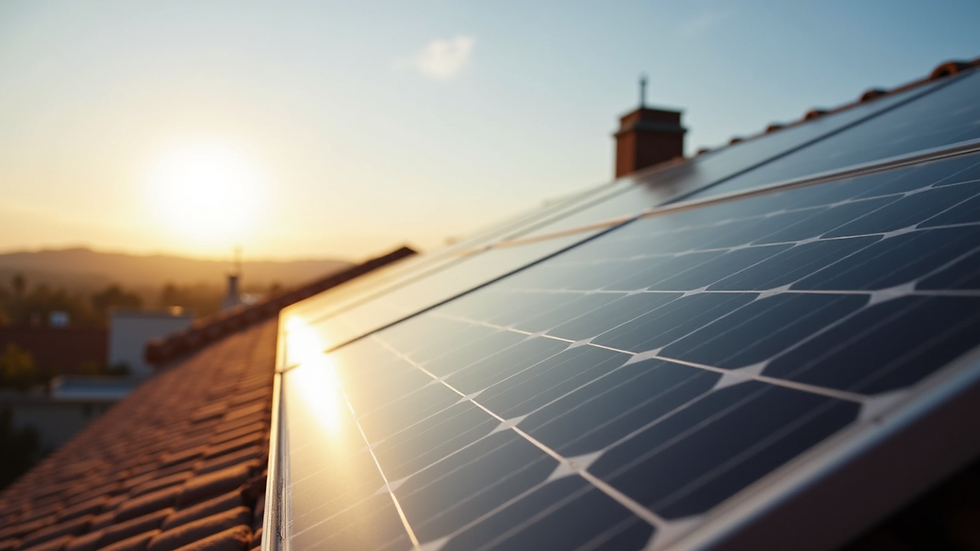Optimizing Solar Panel Longevity in Australia’s Unique Climate Conditions
- Bill Adams
- Aug 20
- 4 min read
Australia's strong sunshine makes it a perfect place for solar energy. However, the country's harsh weather can affect how long and how well your solar panels work. Knowing how to care for your solar panels in this unique environment is key to getting the most out of them for many years.
Understanding the Australian Climate
Australia has a wide range of weather. From intense heat to sudden heavy rains, these conditions can harm solar panels and decrease their efficiency. For instance, in places like Alice Springs, temperatures can reach over 40 degrees Celsius in summer. This can cause panels to overheat, potentially reducing their efficiency by up to 20%. Regular maintenance and understanding these environmental factors are vital for optimal performance.
In addition to high temperatures, strong winds can damage or dislodge solar panels, while dust and debris can block sunlight. For instance, rural areas can accumulate dust quickly, which may lead to a 10% drop in energy absorption. Keeping an eye on these environmental influences will help maintain your solar system's effectiveness.
Regular Cleaning of Solar Panels
Cleaning your solar panels is essential to keeping them efficient. Dirt, dust, and bird droppings can create a barrier that blocks sunlight. In dry regions like the Outback, cleaning may be needed as often as every month, while in coastal areas, it could be less frequent.
Using just water and a soft brush is a safe way to clean the panels. Avoid chemicals that might harm them. If you're unsure about cleaning your panels, it is a good idea to hire professionals who can do it properly.

Inspecting for Damage
Regular checks on your solar system are an important part of maintenance. After severe weather, such as heavy storms or hail, it's especially crucial to look for physical damage. Signs to watch for include cracks, dents, or loose connections.
Making these inspections can help protect your investment. For those less comfortable with checking the system themselves, scheduling annual professional inspections can be a wise option.
Monitoring Performance
Tracking the performance of your solar system is essential. Many systems come with monitoring tools that show energy production. If you see a significant drop in production—by 15% or more—it could signal a malfunction.
Consistent monitoring allows you to address issues quickly, reducing the risk of costly repairs in the future. Focus on how well the inverter is functioning and check if the panels are producing energy reliably.
Addressing Environmental Factors
Environmental aspects, like nearby trees or buildings, can create shade and cut off sunlight to your solar panels. Over time, as trees grow, they may obstruct sunlight and limit efficiency by up to 30% or more.
Regularly review your surroundings and trim or remove branches that may block sunlight. If you plan to introduce new trees or structures, think about how they might affect your solar panels' sun exposure.
Protecting Against Hail and Extreme Weather
Hail can significantly damage solar panels, particularly in regions known for severe weather. Opting for high-quality, hail-resistant panels can help reduce these risks. Many manufacturers offer warranties against hail damage, so be sure to consider this when purchasing.
Additionally, ensuring that your solar installation includes adequate anchoring and risers is essential for wind protection. Consulting with a certified installer can provide you with localized advice tailored to your geographic conditions.
Understanding Warranty and Manufacturer Guidelines
Familiarizing yourself with warranty details and maintenance guidelines from your solar panel manufacturer is crucial. Each model might come with unique care requirements.
Failing to follow these guidelines might void your warranty. Knowing what is expected will give you clarity on maintaining your solar investment and understanding how to maximize its performance and longevity.
Seeking Professional Help
While many tasks can be managed by homeowners, seeking professional help can ensure that your solar system remains in prime condition. Certified technicians come equipped with specialized tools and expertise to identify issues that may be missed by the average homeowner.
Regular maintenance from professionals not only helps extend your system's lifespan but also ensures it functions at its peak efficiency. Consider establishing a routine maintenance schedule with a trusted solar service provider in your area.
Government Incentives and Programs
Australia offers various government incentives and programs to support solar energy use. Many of these programs can help offset the costs of maintenance or upgrades, potentially saving you significant money. For example, some states have rebates that cover up to 50% of maintenance costs.
Staying informed about available opportunities can help ensure your solar system stays in peak condition while also supporting your financial savings.
Final Thoughts
In Australia’s unique climate, maintaining solar panels involves regular cleaning, monitoring performance, and considering environmental impacts that could affect efficiency. By taking proactive steps, including professional inspections and adhering to the manufacturer's guidelines, you can ensure your solar system works effectively for years.
Investing your time in maintenance will not only protect your investment but also support sustainable energy practices across Australia. By embracing the potential of solar energy, let’s commit to keeping our systems in top shape to harness the sun’s power efficiently and effectively.




Comments